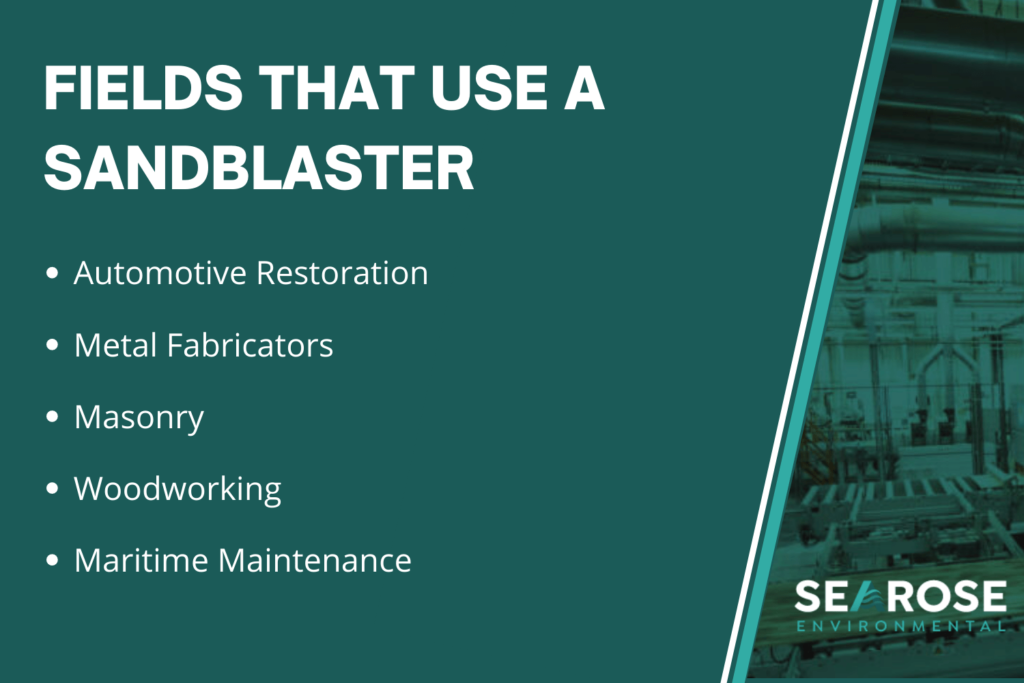Sandblasting is a very efficient, powerful way of cleaning many surfaces of debris. Used across a wide range of industries, sandblasting is extremely common in warehouses and manufacturing facilities – in fact many organisations have their own sandblasting booths where they can regular utilise the technology for cleaning, etching, and removal of products like paint.
Searose Environmental, Queensland’s and New South Wales’s leading provider of sandblasting booth solutions, is here to give you a complete rundown on the sandblasting process, including answering the main questions of “How does a sandblaster work?” and “How much does sandblasting cost?”.
Let’s start with a definition of sandblasting:
What Is Sandblasting?
Sandblasting is a technique that can be used on a variety of different surfaces for cleaning, deburring, and etching by using particles from a proper dry, abrasive material. And yes – you guessed it: sand is the material used to get the job done.
Also known as abrasive blasting, sandblasting is most commonly used in industrial and large scale warehouses.
A sandblaster propels very fine sand particles mixed with high-pressure air at high speed against a surface or material. Coupled with a high-quality, powerful dust extraction system, unwanted debris, grime, and dirt can be removed in the centralised ray of the sandblaster in a safe and clean environment.
Dry Sandblasting vs. Wet Sandblasting
There are two different methods of sandblasting: dry sandblasting, and wet sandblasting. Let’s look at the difference:
Dry Sandblasting: Dry sandblasting relies on compressed air and abrasive materials to clean a surface. This method is best used on hard materials such as metal or stone.
Wet Sandblasting: Wet sandblasting, on the other hand, uses a mixture of water and abrasive sand material. Under high pressure, this combination is typically used on softer surfaces, for example, wood or plastic, to prevent damage to more delicate materials. Wet sandblasting is considered somewhat better for technicians as it creates less dust than dry sandblasting and does not have an impact on lungs.

What Surfaces Can Be Sandblasted?
Sandblasting is typically used in large scale cleaning projects. There are a lot of materials where a sandblaster provides the most effective and efficient clean. Here are a few examples:
- Plastic
- Wood
- Masonry
- Stone
- Ceramics
- Glass
- Concrete
- Steel
- Aluminium
- Copper
However, it is essential to ensure that the material that the sandblaster is used on can manage the power of the equipment. Thin plastic, metal, and painted surfaces are materials that should be avoided for dry sandblasting. These materials will not be able to withstand the force, resulting in breakage, scratches, or dents.
Safety equipment is also a crucial necessity while sandblasting, as sandblasting creates a large amount of dust. If inhaled, it can be harmful to your lungs.
What Are the Benefits of Sandblasting?
Using a sandblaster to clean, deburr, etch and remove products (like paint) from surfaces will yield extremely efficient and effective results. With the right precautions, there are many benefits to using sandblasting, including:
Simple to Operate
If you know what you’re doing, sandblasting relies on easy to operate equipment and processes. A sandblasting technician will use adequate safety equipment such as gloves, safety goggles, and a mask. The process will also be completed in a sandblasting booth to keep the project to a secluded area that does not affect the rest of the working space.
Efficient Process
The sandblasting process itself is swift and effective. If completed correctly, you will see clean, even, and smooth results.
Extremely Versatile
Sandblasting is used in a wide variety of industries. Here are a number of examples from industries that use sandblasters regularly:
- Automotive: During automotive repair and restoration, sandblasting removes rust, paint, and other contaminants from vehicle parts.
- Metal & manufacturing: Metal fabrication uses sandblasting for cleaning, deburring, and etching. Guaranteeing a smooth and uniform metal surface.
- Stone and masonry: Sandblasting offers a very efficient process for stone and masonry cleaning, removing dirt and grime in no time.
- Woodworking: For woodworking, sandblasting offers an efficient way of creating smooth and uniform finishes.
- Maritime: Sandblasting is extremely valuable when it comes to maritime maintenance. Dirt and debris on boat hulls and marine parts don’t stand a chance against the pressure of a sandblaster.
These are just a few examples that show the versatility of sandblasting across many businesses and hobbies. Generally, if you want to clean, deburr, and etch a solid or resilient surface or material, sandblasting an ideal solution.

Sandblasting Is Environmentally Friendly
Sandblasting relies on sand, pressure, and water (for wet sandblasting). As no chemicals or toxic materials are involved in the sandblasting process, it is not causing harm to the environment.
How Much Does Sandblasting Cost?
The cost of sandblasting varies from job to job. The main factors that decide the price of professional sandblasting are the size of the surface and the method needed to get the job done. Generally, sandblasting costs around $50 to $150 an hour.
Most operations rely on a sandblasting company for one off sandblasting and abrasive cleaning jobs. However, if you regular need to use sandblasting on a regular basis, consider installing a sandblasting booth in your warehouse to bring this process in-house.
Searose Environmental are the leading providers of sandblasting booth soltuions across NSW and QLD. For more information on installing a booth, get in touch with our friendly team today. We can talk you through the process and provide an accurate quote on sandblasting booth installation today.
